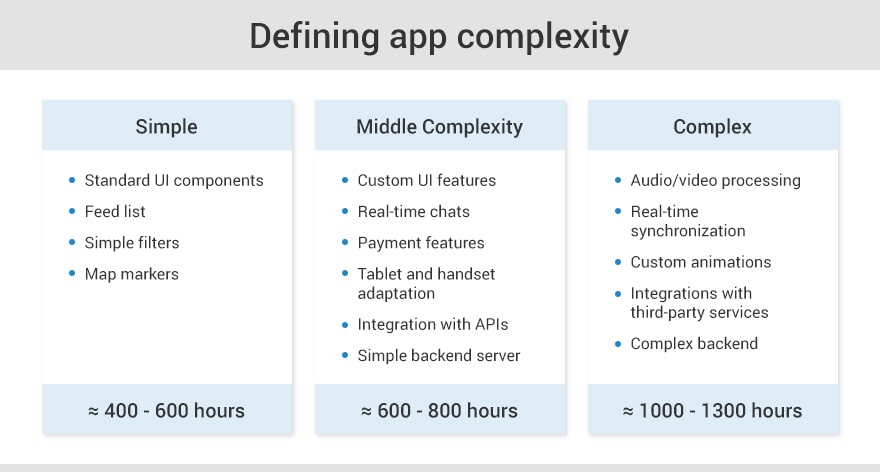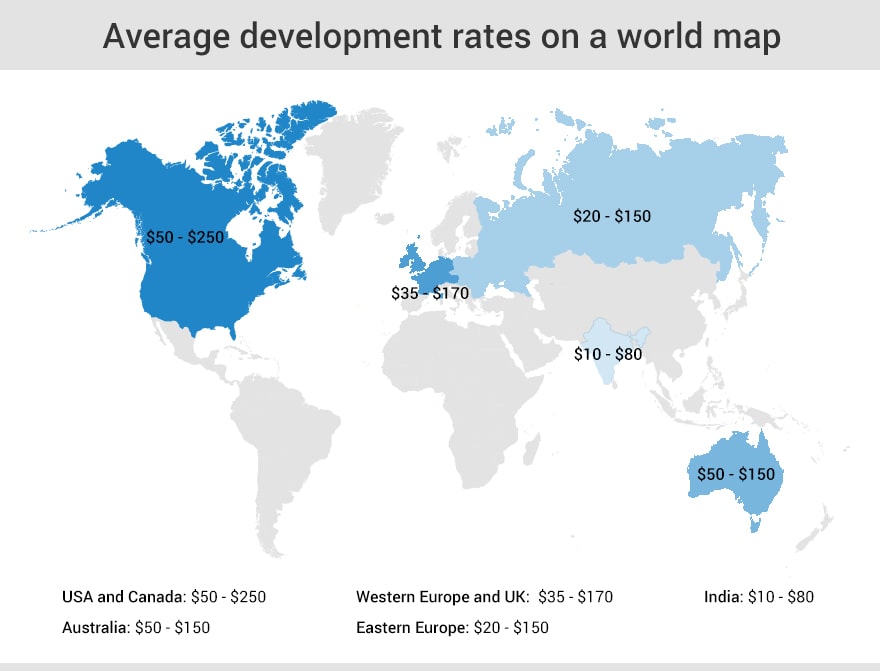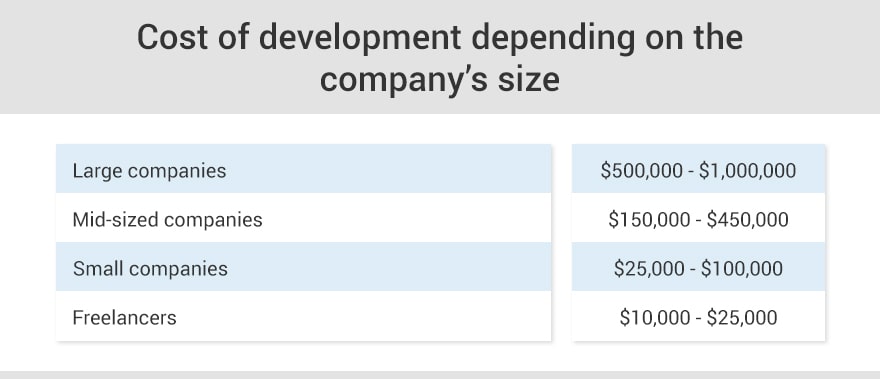How Much Does It Cost to Develop a Mobile App?
It’s not a secret that for most customers, the key question associated with mobile app development lies in its cost since we’re all interested in getting a high-quality product at a reasonable price.
This way, knowing the costs of making a mobile app is vital for both businesses and individuals, as expenses can differ based on various factors affecting the development process.
This article delves into the details of mobile app development costs, giving insights into the main factors, types of apps, ongoing expenses, and ways to save on development costs.
Factors Influencing The Cost
The main factors that need to be taken into account when creating a mobile app include:
- Product type
- Product complexity
- After-release support
- Hourly Rates
- App development team
Let’s take a deeper view of each.
Product Type
The cost for app development highly depends on its type. Basically, you have two options: native or hybrid mobile app. While native apps are developed to work with one particular platform (iOS, Android, Windows phone, etc.), hybrid and cross-platform apps are created for all platforms altogether.
Usually, the price depends on the number of platforms and devices that need to be supported. As a rule, the custom app development for iOS is less expensive than for Android.
It’s because the number of iOS devices is much less than a wide variety of Android devices.
Although the main factor to consider is the client’s preferences, it is also important to determine devices/OS versions present in a particular market and define the market share for each Android device manufacturer and OS version.
Still, quite often, customers decide to support only the most popular Android devices, and in such cases, they can limit Android app development costs. But if a customer chooses to support some more devices, the app price exceeds exponentially.
Choosing additional models means more time spent on adapting the application for various screen sizes, resolutions, hardware specifications, and testing.
Product Complexity
The technical complexity of an application should be taken into account while estimating its development cost.
The more difficult the functionality, the more time required to implement it, and the more professionals are to be involved in the development process.
If we subdivide mobile apps by complexity, we’ll get the following types: simple, middle complexity, and complex apps. The picture below illustrates the difference between these three:

Let’s take an average hourly rate on the development of $50.
According to the picture above, a simple mobile application might cost from $20,000 to $30,000; a middle complexity app will vary from $30,000 to $40,000; prices on complex mobile applications will start from $50,000.
The average time needed to develop an app starts at 400 hours. Still, note that development time also depends on the technical complexity of the desired app, the number of talents working on it, the number of devices and OS, custom designs and animations, and so on.
Also, quite often, but not exclusively, Android app development takes 10-20% more time than application development for iOS, meaning that the cost of an Android app often exceeds that of an iOS one.
After-Release Support
One of the most important things to remember while planning a budget for an app is the after-release support. Usually, it is not included in the initial estimate but makes a huge impact on the product’s success.
After-release support may include the following:
- Updates to the app
- New features creation
- Internalization
- Extend to the next platform
- Back-end server maintenance
- Cloud hosting
- Legal support
- Marketing and promotion
Hourly Rates
The price of an app might vary depending on the place where it is developed.
In some countries, the prices of development are sky-high (US, Canada), whereas some others provide quite reasonable prices.
So, depending on the region, hourly rates vary from $10 to $250, as shown in the picture:

Considering such differences in hourly rates, it is no wonder many US and Canadian customers are opting for outsourcing mobile app development.
Nevertheless, there are also those who wrongly believe that the higher the price — the better the quality. In fact, middle and lower-priced mobile app developers are often known for providing excellent results. So, let’s move on and look at the mobile app development companies.
Choosing a Vendor
Meanwhile, the size of the vendor company might depend on the price of the development.
As a rule, the larger the company is — the higher the price.

As seen, the price of mobile application development offered by freelancers is much lower than the price offered by mid-sized providers.
App Development Team
The size of the development team also affects the price of the app. The larger the project and the higher the requirements — the more programmers should be involved in the development process and, as a result, the higher the overall price. Conditionally, we can subdivide teams into basic and extended.
A basic team is generally made up of the following professionals:
- Project Manager
- Android/iOS app developers (two or more)
- QA Engineer
An extended team generally includes all the players of a basic team plus:
- Business Analyst
- UI/UX Designer
- Admin panel designer
- Front-end developer
- Back-end developer (if needed)
- DevOps
- Both iOS and Android developers
Types of Apps
Mobile apps are as diverse as the people who use them. From simple tools that provide information to complex platforms for social connections or gaming, mobile apps come in various types, each serving specific needs.
Informational Apps
Informational apps are designed to provide users with valuable content or resources. They can include news apps, educational tools, or reference guides.
Typically, these apps have lower development costs due to their austere functionality — their primary goal is simply to present information in an appealing manner.
Examples: Wikipedia, news apps, language learning apps.
E-commerce Apps
E-commerce apps allow users to make online transactions, browse products, make purchases, and manage their accounts. These apps often have features like secure payment gateways and order tracking.
Development costs for e-commerce apps can vary widely based on the complexity of features, integration with payment systems, and security measures.
Examples: Amazon, eBay, Etsy.
Social Networking Apps
Social networking apps connect people, help them share content, and build online communities. These apps often include features like profiles, messaging, and multimedia sharing.

Developing social networking apps can be complex, with costs impacted by user interface features and scalability plans.
Examples: Facebook, Instagram, LinkedIn.
Gaming Apps
Gaming apps provide interactive and entertaining experiences, ranging from casual games to sophisticated, graphics-intensive projects.
The development cost of gaming apps is often higher due to the need for advanced graphics, complex gameplay mechanics, and potential multiplayer features.
Examples: Candy Crush, PUBG, Among Us.
App Maintenance and Ongoing Costs
Once an app is live in app stores, users expect it to function flawlessly without bugs and glitches.
To keep a mobile app up and running after launch, you need to ensure its ongoing maintenance and support.
The ongoing maintenance costs involve continuous monitoring, updates, and enhancements needed to meet user expectations, address security concerns, and stay compatible with the latest operating systems.
To allocate your budget accurately, estimate yearly maintenance expenses considering factors like app complexity, update frequency, user base size, and technological changes.
The ongoing involvement of the app development team, whether in-house or external, is also a crucial factor in efficient maintenance since you utilize their knowledge for quick bug fixing, updates, and improvements.
App Cost Breakdown
Creating a mobile app involves various stages, each contributing to the overall cost. Understanding the list of these costs is essential for correct budgeting and project management.
User Interface/User Experience (UI/UX) Design
The design phase is crucial for creating an engaging and convenient app. Usually, it includes:
- Wireframing and Prototyping: Planning the app’s structure and user flow.
- Graphic Design: Creating visually appealing elements.
- UI/UX Testing: Providing a good user experience.
Investing in a well-designed app is necessary to attract and retain users, but it can significantly add to the overall cost.
Development
Development is where the app comes to life. Key components of development costs include:
- Front-end Development: Creating the user interface and user interactions.
- Back-end Development: Building server-side functionality and databases.
- Integration of Features: Executing various functionalities and services.
The app’s complexity, the quantity of features, and the technology used all impact the development costs.
Quality Assurance (QA) and Testing
Making the app function correctly and free it from bugs is crucial for its success. Testing normally includes:
- Functional Testing: Confirming each feature works as intended.
- Compatibility Testing: Demonstrating the app works on various devices and operating systems.
- Security Testing: Identifying and addressing potential issues.
Investing in thorough testing reduces the risk of post-launch issues but adds to the overall development cost.
Ongoing Maintenance
Post-launch activities are essential for the app’s longevity. Ongoing maintenance includes:
- Regular Updates: Keeping the app compatible with the corresponding devices and the latest OS versions.
- Bug Fixes: Addressing issues reported by users.
- Enhancements: Implementing new features or adjusting existing ones based on user preferences.
While many focus on the initial development cost, it’s important to allocate resources for post-launch activities. Resources for ongoing maintenance, updates, and improvements ensure the app remains viable and competitive.
Current App Development Team
The cost of the development team, including salaries, benefits, and overheads, contributes to the overall project cost. Factors affecting this cost include:
- Geographical Location: Development in regions with higher living expenses generally leads to higher hourly rates.
- Experience and Skill Level: Highly skilled and experienced engineers may request higher compensation.
Pricing Models Used by App Development Agencies
Choosing the right pricing model can greatly impact your mobile app development project. App development agencies offer various pricing structures, each with advantages and considerations.
Time and Material
Per time&material approach, clients pay based on the number of hours worked by the development team on their project.

- Advantages: The hourly structure is well-suited for projects with growing demands or situations when clients want to monitor the development’s progress.
- Considerations: Hourly rates may result in higher costs if the project goes beyond the initial discussions. Additionally, budgeting for such a payment model can be challenging if the project scope is not well-defined.
Project-Based
A project-based model implies paying a fixed price rate agreed upon for the entire project, regardless of the hours spent.
- Advantages: Clients know the total cost upfront.
- Considerations: In case of unexpected changes in project scope, a client may get extra charges.
Outstaffing
Per the outstaffing model, clients hire mobile app developers and designers to work exclusively on their projects.
- Advantages: Upon the outstaffing structure, a client gets a team that focuses solely on the project while paying less than hiring an in-house team.
- Considerations: Although outstaffing is one of the best ways to develop an app, it requires effective communication and project management from the team, especially when team members are in different time zones.
Dedicated Team
A dedicated team resembles the outstaffing model, but the client has more control over team composition and project management.
- Advantages: Clients have more influence over the development process.
- Considerations: Clients need to handle project management and maintain team coordination and communication.
Saving on App Development Costs
Developing an app can be a nightmare for your budget. Luckily, there are some strategies that proved to be helpful in reducing an average app development cost:
- MVP (Minimum Viable Product): MVP development implies creating only the essential features that make your app functional and valuable to users. After the app release, you can collect feedback and make adjustments based on user needs.
- Prioritizing Features: By focusing on essential features, you can manage development costs more wisely. Prioritize features for the initial release and plan subsequent updates for extra functionalities.
- Thorough Planning: Provide clear and comprehensive documentation of your app requirements since well-documented plans minimize miscommunication and prevent costly changes.
- Good Communication: Maintain open communication with the development team and provide timely feedback to avoid rework and keep the project on track.
Saving on app development costs is about making strategic decisions at every stage of the process. By adopting a consistent and holistic approach, focusing on essential features, and considering all possible nuances, you can create a high-quality app.
Conclusion
You can’t expect to build an amazing app for just a few dollars. But at the same time, spending a ton doesn’t automatically translate to success. Hope our descriptive app development cost approach can be helpful in estimating the approximate price of the desired application. However, the exact price of an application might vary from company to company. Keeping in mind the factors that influence the cost deepens the understanding of the development process, helps to decide on the app’s type and functionality and choose the most suitable mobile application development company like SCAND. If you want to discuss your project and learn about the possible stumbling blocks in app development – contact us. We will provide you with a free consultation and select an adequate tech stack for your app.















